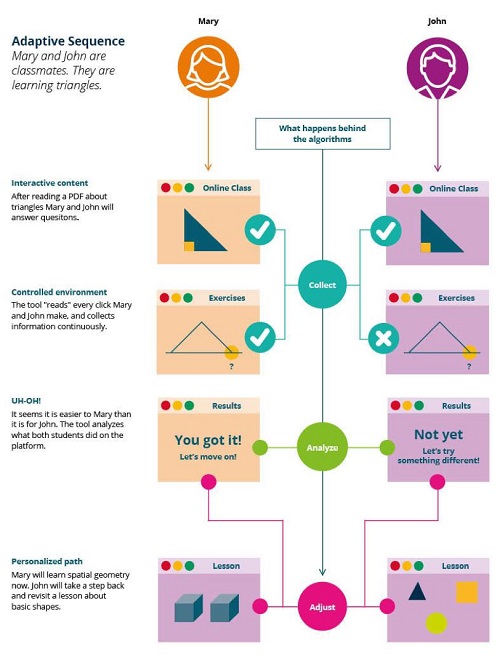Characteristics of a smart learning environment
Characteristics of a smart learning environment
One can begin to think about what functions and features are expected of a smart learning environment? From our knowledge in the previous module, a key motivation for designing SLE to support learning and teaching is connected to the kind of features that improves the user experience. Experts have expressed what makes a system smart in the context of education . For example, a learning environment can be considered smart when it makes use of adaptive technologies or when it is designed to include innovative features and capabilities that improve understanding and performance. In a general sense, a smart learning environment is one that is "effective, efficient and engaging” (Spector, 2014, p.2).
Sirkka Freigang described a smart learning environment to constitute the features represented in the figure below

Technical Features of SLE
- Tracking learning process. The SLE can track the learning status of learners to enable a more accurate support for learning.
- Recognizing learning scenario. Personalized resources will be identified according to the learning event, which includes the learning time, place, peers and activities.
- Awareness of the physical environment . The air, temperature, light, sound, and smell will be monitored and adjusted to accommodate learners' needs.
- Connecting learning community. Learners will be connected to learning communities to enrich the learning experience
Hwang (2014) criteria for a smart learning environment:
- Detect and take into account the real-world contexts.
- Situate learners in real-world scenarios.
- Adapt learning interfaces for individual learners.
- Adapt learning tasks for individual learners.
- Provide personalized feedback or guidance.
- Provide learning guidance or support across disciplines.
- Provide learning guidance or support across contexts.
- Recommend learning tools or strategies.
- Consider learners' online learning status.
- Consider learners' real-world learning status.
- Facilitate both formal and informal learning.
- Take multiple personal and environmental factors into account.
- Interact with users via multiple channels.
- Provide learners with support in advance, across real and virtual contexts
Broad classification of the characteristics of SLE
1. AdaptivityAdaptivity is the state or quality of being adaptive. A smart learning environment has the capacity to adapt to different contextual scenarios. For instance, a learning environment is smart if it is capable of adapting instructional process on different instructional parameters such as sequence of tasks, task difficulty, time, type of feedback, pace or learning speed, reinforcement plan, etc. The adaptations of the instructional process to the individual have been investigated from different research perspectives, for example, research in learner modeling, intelligent tutoring systems, adaptive hypermedia, adaptive instructional designs and others.
For instance, a tool designed with adaptive sequence has a lot going on behind the scenes. This tool is continuously collecting and analyzing student data to automatically change what a student sees next; from the order of skills a student works on, to the type of content a student receives. Example of an algorithm for an adaptive sequence in a learning environment used by John and Mary is presented below.

For further reading on adaptivity, see https://moodle.uef.fi/mod/folder/view.php?id=1690544
2. Personalization
According to the US Department of Education, Office of Educational Technology, personalized learning refers to instruction in which the pace of learning and the instructional approach are optimized for the needs of each learner. Learning objectives, instructional approaches, and instructional content (and its sequencing) may all vary based on learner needs. In addition, learning activities are made available that are meaningful and relevant to learners, driven by their interests and often self-initiated.
Hence, in a personalized learning environment,
- The pace of learning is adjusted
- Learning objectives, approaches, content, and tools are tailored and optimized for each learner
- Learning is driven by learner interests
- Learners are given choice in what, how, when, and where they learn
- Learning is often supported by technology
For examples, WileyPLUS, introduced in the embedded video shows how a learning environment personalizes learning
3. Context and Location-awareness
According to Hwang (2014), a smart learning environment is context-aware; that is, the learner’s situation or the contexts of the real-world environment in which the learner is located are sensed, implying that the system is able to provide learning support based on the learner’s online and real-world status. As presented in the table, a smart learning environment is able to identify, recognize, understand and become aware of the phenomenon, event, object, impact, etc of learners context such as lights, temperature, humidity, sound, etc. Read this article provided on context-awareness for more understanding of the concept.
SLE characteristics, technologies, and smartness activities (Adapted from Uskov et al., 2015) |
Tools, agents, technologies involved | Smart Activities | |
Adaptive: |
| |
Sensing: |
| |
Inferring: |
|
|
Learning/knowledge acquisition: |
| |
Anticipating: |
(predictive analytics) | · All the above |
References
Spector, J. M. (2014). Conceptualizing the emerging field of smart learning environments. Smart learning environments, 1(1), 2.
https://blog.bosch-si.com/future-of-work/iot-in-education-by-designing-smart-learning-environments/
Hwang, G. J. (2014). Definition, framework and research issues of smart learning environments-a context-aware ubiquitous learning perspective. Smart Learning Environments, 1(1), 4.
Uskov, V. L., Howlett, R. J., & Jain, L. C. (Eds.). (2015). Smart education and smart e-learning (Vol. 41). Springer.
